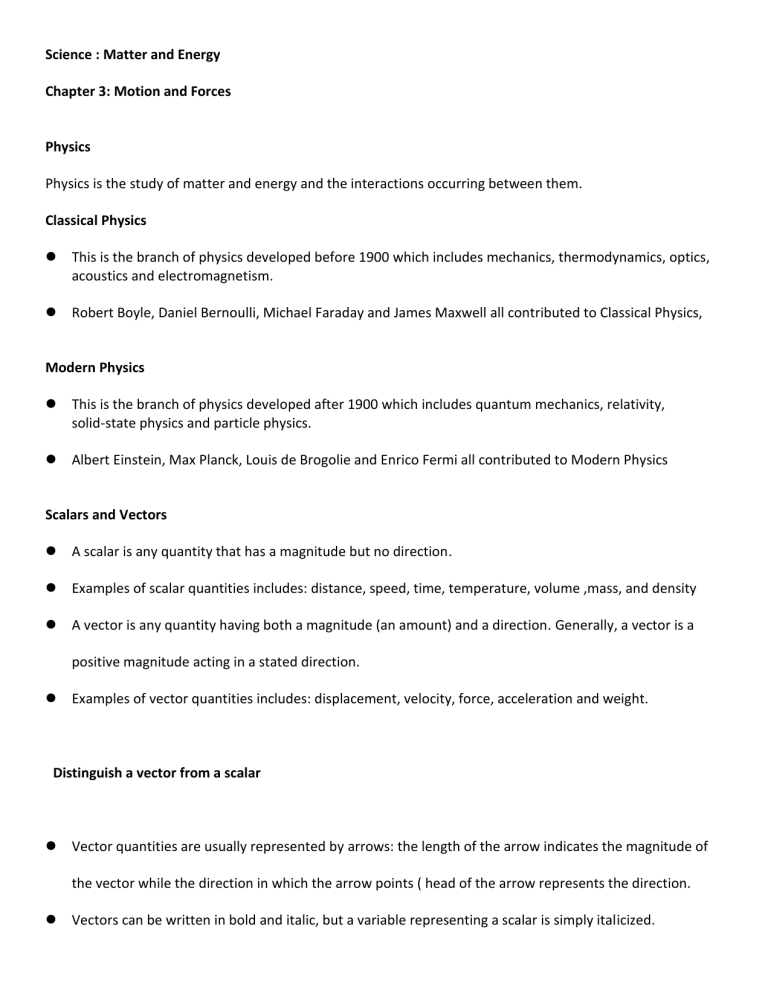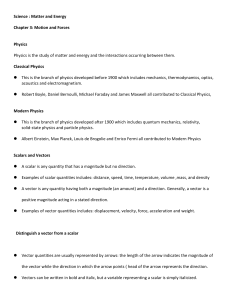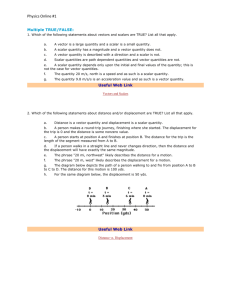
Science : Matter and Energy Chapter 3: Motion and Forces Physics Physics is the study of matter and energy and the interactions occurring between them. Classical Physics This is the branch of physics developed before 1900 which includes mechanics, thermodynamics, optics, acoustics and electromagnetism. Robert Boyle, Daniel Bernoulli, Michael Faraday and James Maxwell all contributed to Classical Physics, Modern Physics This is the branch of physics developed after 1900 which includes quantum mechanics, relativity, solid-state physics and particle physics. Albert Einstein, Max Planck, Louis de Brogolie and Enrico Fermi all contributed to Modern Physics Scalars and Vectors A scalar is any quantity that has a magnitude but no direction. Examples of scalar quantities includes: distance, speed, time, temperature, volume ,mass, and density A vector is any quantity having both a magnitude (an amount) and a direction. Generally, a vector is a positive magnitude acting in a stated direction. Examples of vector quantities includes: displacement, velocity, force, acceleration and weight. Distinguish a vector from a scalar Vector quantities are usually represented by arrows: the length of the arrow indicates the magnitude of the vector while the direction in which the arrow points ( head of the arrow represents the direction. Vectors can be written in bold and italic, but a variable representing a scalar is simply italicized. For instance, suppose we have a certain displacement that is 20 m left. If we use v to represent the vector, we may write “v = - 20 m” or “v = 20 m left.” On the other hand, if we merely wanted to discuss the magnitude of the movement (distance, the scalar), we would write “v = 20 m.” In formulas, we can tell the difference between vectors and scalars by putting an arrow over the symbols for the vectors quantities. For example : x is a scalar and it tells us how far away from the origin the object is but it does not tell us the direction. An object’s position in one dimension can be represented as the vector x. This represents both the distance from a certain point and the direction( left or right ect.) Distance and Displacement in one dimension Distance (d) is a scalar quantity representing the total length of an objects path. Displacement is a vector quantity representing an object change in position. Displacement ( change in position) = final position - initial position This equation represents displacement in one direction. Distance depends only on the path taken while displacement depends on the initial and final positions. http://physics.bu.edu/~duffy/ns540_fall10_notes01/EP_ch02_2dash1to2dash4.pdf







